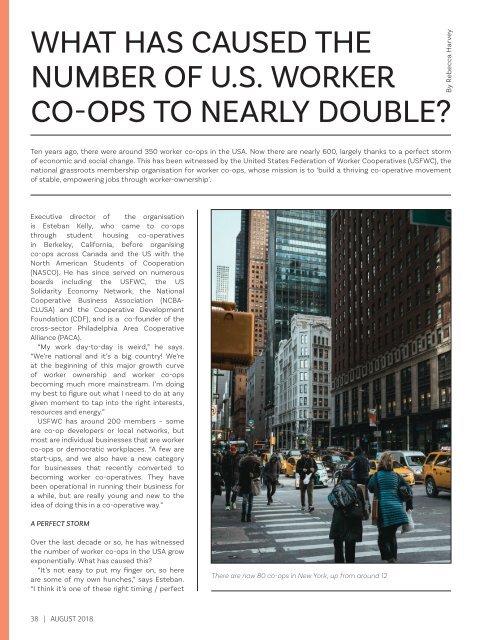AUGUST 2018
The August edition of Co-op News looks at how the co-operative movement can grow - but also thrive. Plus case studies from the US worker co-op movement, and how co-ops are embracing spoken word to tell the co-op story.
The August edition of Co-op News looks at how the co-operative movement can grow - but also thrive. Plus case studies from the US worker co-op movement, and how co-ops are embracing spoken word to tell the co-op story.
You also want an ePaper? Increase the reach of your titles
YUMPU automatically turns print PDFs into web optimized ePapers that Google loves.
WHAT HAS CAUSED THE<br />
NUMBER OF U.S. WORKER<br />
CO-OPS TO NEARLY DOUBLE?<br />
By Rebecca Harvey<br />
Ten years ago, there were around 350 worker co-ops in the USA. Now there are nearly 600, largely thanks to a perfect storm<br />
of economic and social change. This has been witnessed by the United States Federation of Worker Cooperatives (USFWC), the<br />
national grassroots membership organisation for worker co-ops, whose mission is to ‘build a thriving co-operative movement<br />
of stable, empowering jobs through worker-ownership’.<br />
Executive director of the organisation<br />
is Esteban Kelly, who came to co-ops<br />
through student housing co-operatives<br />
in Berkeley, California, before organising<br />
co-ops across Canada and the US with the<br />
North American Students of Cooperation<br />
(NASCO). He has since served on numerous<br />
boards including the USFWC, the US<br />
Solidarity Economy Network, the National<br />
Cooperative Business Association (NCBA-<br />
CLUSA) and the Cooperative Development<br />
Foundation (CDF), and is a co-founder of the<br />
cross-sector Philadelphia Area Cooperative<br />
Alliance (PACA).<br />
“My work day-to-day is weird,” he says.<br />
“We’re national and it’s a big country! We’re<br />
at the beginning of this major growth curve<br />
of worker ownership and worker co-ops<br />
becoming much more mainstream. I’m doing<br />
my best to figure out what I need to do at any<br />
given moment to tap into the right interests,<br />
resources and energy.”<br />
USFWC has around 200 members – some<br />
are co-op developers or local networks, but<br />
most are individual businesses that are worker<br />
co-ops or democratic workplaces. “A few are<br />
start-ups, and we also have a new category<br />
for businesses that recently converted to<br />
becoming worker co-operatives. They have<br />
been operational in running their business for<br />
a while, but are really young and new to the<br />
idea of doing this in a co-operative way.”<br />
A PERFECT STORM<br />
Over the last decade or so, he has witnessed<br />
the number of worker co-ops in the USA grow<br />
exponentially. What has caused this?<br />
“It’s not easy to put my finger on, so here<br />
are some of my own hunches,” says Esteban.<br />
“I think it’s one of these right timing / perfect<br />
There are now 80 co-ops in New York, up from around 12<br />
38 | <strong>AUGUST</strong> <strong>2018</strong>


















